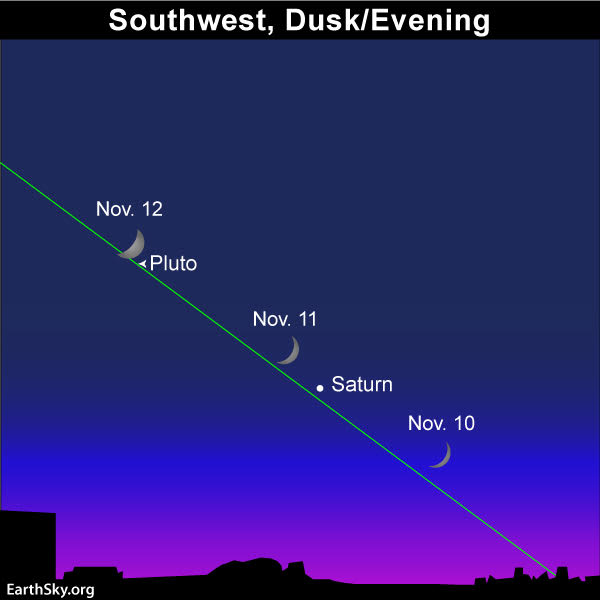Moon, Saturn, Taurid meteors this weekend
Bruce McClure in TONIGHT | November 10, 2018
This weekend – Saturday, November 10, and Sunday, November 11, 2018 – you’ll find the moon and Saturn at early evening. More about the pair below. Also, the North Taurid meteors at their best at and around the midnight hour. For the fun of it, on our chart at top, we also show you the whereabout of the dwarf planet Pluto. You won’t see Pluto with the eye; it’s about 2,000 times fainter than the dimmest visible star.
About the North Taurids … A crescent moon in the west in the evening is a setting moon. So moonlight will not obstruct this year’s North Taurid meteor shower. The moon (along with the planet Saturn) will set by early to mid-evening, while the North Taurids will fly most abundantly for several hours, centered around 12:30 a.m. local time (the time on your clock no matter where you are on the globe). This shower offers perhaps five or so meteors per hour, but it’s known for producing fireballs.
About the moon and Saturn … At nightfall on November 10 and 11, look westward for the waxing moon. The ringed planet Saturn will be the bright “star” nearby. Although you can see Saturn with the eye alone, you need a telescope to view its glorious rings. Even a modest backyard telescope will do the trick.
November 2018 presents your last full month to observe Saturn in the evening sky. This golden world will become lost in the sun’s glare in December 2018. It’ll move over into the morning sky in early January 2019.
The moon, our closest celestial neighbor, resides a bit less than 250,000 miles (400,000 km) from Earth at present. Meanwhile, Saturn, the farthest world that we can easily see with the unaided eye, lodges at about four thousand times the moon’s distance from Earth.
Watch the moon over the next several days as it goes eastward relative to the backdrop stars and planets of the zodiac. Even though the moon and Saturn move westward across the sky throughout the night – because of the Earth’s rotation – the moon continually moves eastward in front of the constellations of the zodiac. So, from one night to the next, you’ll find the moon in a more easterly position. This motion is due to the moon’s eastward orbital motion around Earth.
As the moon makes its monthly rounds through the zodiac, it’ll meet up with the red planet Mars in mid-November. In fact, if you at the right spot in the far southern part of the globe, you could watch the moon occult (pass in front of) Mars. From most of the globe, however, the moon will pass just south of Mars and no occultation will take place.
 |
 |
|
|||||||||||
 |
 |
||||||||||||
|
|
|
|
|
|
|
||||||||
 |
|
|
|
|
|
 |
|||||||
|
|
|
|
|||||||||||
|
|
|||||||||||||
|
|
|
|
|
|
|
|
|
|
|
|
|
|
|
Results 1 to 1 of 1
Thread: Moon Saturn Taurid meteors
-
11-11-2018, 01:11 PM #1
Moon Saturn Taurid meteors
Last edited by ilan; 11-11-2018 at 01:14 PM.
Beginner's Guide for Rocket, NFPS and IKS66...
http://iptvtalk.net/showthread.php?2...-you-should-do
Kodi Options for Rocket, NFPS and IKS66...
http://iptvtalk.net/forumdisplay.php?71-Kodi
Check the Announcement Section...
http://iptvtalk.net/forumdisplay.php...-Announcements
Similar Threads
-
Young moon, Jupiter, Saturn glorious December 15 to 18!
By ilan in forum Maps to the StarsReplies: 0Last Post: 12-15-2020, 01:27 PM -
Picture of the Day: Saturn Moon Mimas
By ilan in forum The Universe at a GlanceReplies: 0Last Post: 08-06-2019, 11:38 PM -
Beta Taurid meteor shower - video
By ilan in forum The Universe Closer to HomeReplies: 0Last Post: 05-17-2019, 11:49 AM -
Moon and Saturn to meet in morning sky
By ilan in forum Maps to the StarsReplies: 0Last Post: 04-24-2019, 12:19 PM -
Moon and Saturn
By ilan in forum Maps to the StarsReplies: 0Last Post: 05-31-2018, 12:16 PM







 Reply With Quote
Reply With Quote